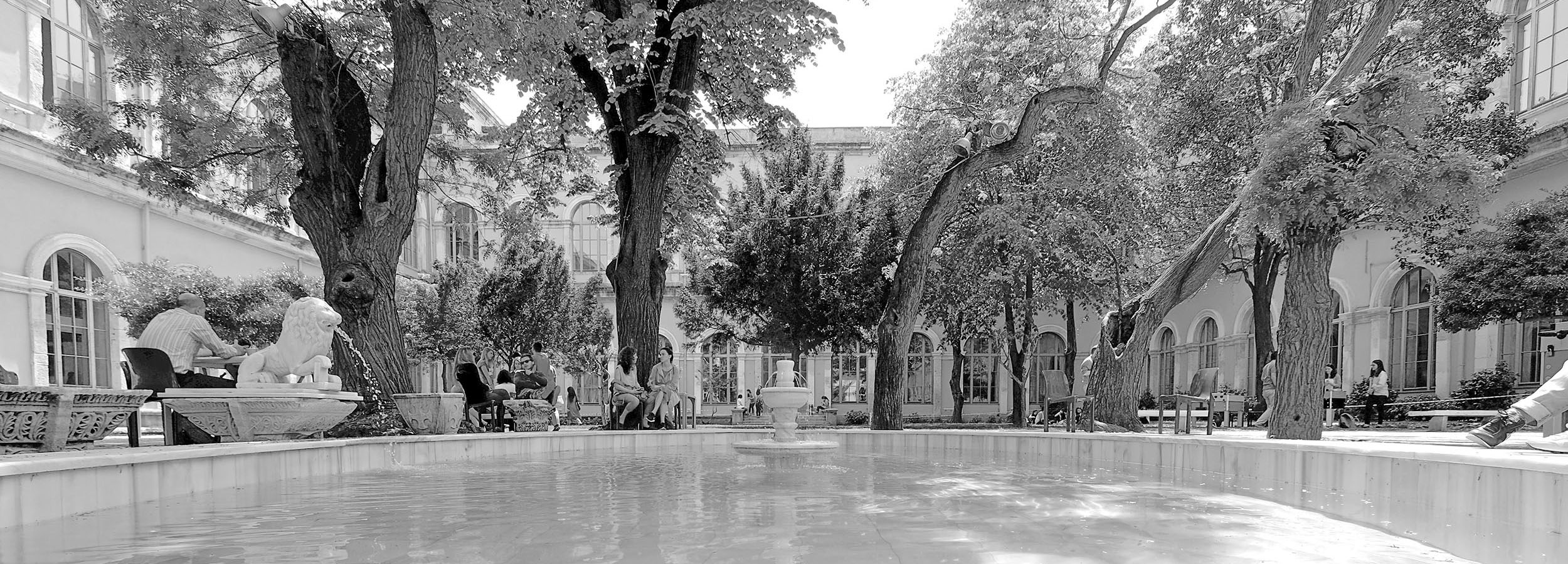
Taşkışla: Our Building
Designed by English architect William James Smith Taşkışla was built to provide the Medical School with modern equipment in a brand-new masonry building.
The construction programme consisted of a school that could accommodate 300 students and an educational clinic for 200 patients. These were complemented with a pharmacy, laboratories, a morgue, a mosque, a clock tower, two pools and an imperial administration office, as well as various other administrative departments. The foundation stone laying ceremony was held on 24 February 1847, under the auspices of Sultan Abdülmecid. In 1849 the building was converted into military barracks while construction works were still continuing.
Taşkışla was used as a military hospital for French soldiers during the Crimean War (1853-56). The building saw renovation works during the reign of Sultan Abdülaziz and resumed its operation as military barracks.
Damaged by a powerful earthquake in 1894, the building was restored by eminent architects, Raimondo D’Aronco and Alexander Vallaury. During the Balkan Wars Taşkışla was again used as a hospital, and was finally allocated to Istanbul Technical University in 1944. In accordance with the renovation and adaptive re-use projects prepared collaboratively by Professor Paul Bonatz and Professor Emin Onat, the building housed the faculties of Architecture and Civil Engineering as well as the Rectorate.
A lofty courtyard with a decorative oval pool encircled by linden trees is set within the building which is designed as a quadrangle. Today the spaces on the east and west legs of the building house academic staff offices and spaces facing the courtyard are occupied by design studios. Large lecture theaters are placed on the northern and southern ends. A Neo-Renaissance style is predominant in the facades and architectural elements. String courses highlighting the floors and a horizontal line of cornices form the building’s strong geometrical and structural facade expression. The disciplined use of ornaments and bold predominance of the portico rising over eight fluted Ionic columns provide a stable integrity and a calm simplicity to the building’s architectural character.
Education and Research
ITU Faculty of Architecture consists of five undergraduate programs. Currently more than 3000 students are enrolled in the following programmes: Architecture, Urban and Regional Planning, Interior Architecture, Landscape Architecture and Industrial Design.
ITU Faculty of Architecture offers a wide-range of professional and research based postgraduate programs.
Facilities
IT U Faculty of Architecture consists state-of-the-art labs and workshops for the use of both undergraduate and graduate students and researchers. The Faculty accommodates seven research labs including the Construction Materials Lab, Environmental Control and Construction Technologies Lab, Innovation and Modelling Lab, Digital Fabrication Lab, Conservation and Restoration Lab, Industrial Design Lab, IstanbulON Urban Mobility Lab and MIX-R Experience (Mixed Reality Lab) along with Rapid Prototyping and Metalworking Lab, Fine Arts Workshop and Ceramic Workshop.
U Faculty of Architecture consists state-of-the-art labs and workshops for the use of both undergraduate and graduate students and researchers. The Faculty accommodates seven research labs including the Construction Materials Lab, Environmental Control and Construction Technologies Lab, Innovation and Modelling Lab, Digital Fabrication Lab, Conservation and Restoration Lab, Industrial Design Lab, IstanbulON Urban Mobility Lab and MIX-R Experience (Mixed Reality Lab) along with Rapid Prototyping and Metalworking Lab, Fine Arts Workshop and Ceramic Workshop.
The Faculty Library is located on the ground floor of Taşkışla cataloguing reference books within the fields of architecture, urbanism and design. It also has a collection of the theses completed at the Faculty of Architecture. Additionally, our periodicals library is situated on the first floor where students can enjoy a quiet working environment.
Taşkışla building has three conference halls. No. 109 designed by the famous Turkish architect Nezih Eldem can host up to 250 persons. No.127 is preferred for seminars and symposiums alongside our newly renovated No.126 which is equipped with high-tech audio and visual systems.
International Relationships
Since its foundation in the late nineteenth century, our school has always prioritized establishing strong international relationship with leading professionals and schools across the world. Paul Bonatz, Paolo Verzone, Wilhelm Tiedje, Gustav Oelsner, Rudolf Belling and Clemens Holzmeister are amongst the many leading foreigners who taught at our school in the twentieth century.
Based on this strong tradition we continue to expand our international collaborations with different parts of the world. In 2008 ITU Faculty of Architecture became the first school in the world that obtained recognition from the National Architecture Accreditation Board (NAAB) outside the United States of America.
Under Erasmus+ Program ITU Faculty of Architecture has signed bilateral agreements with over 100 schools of architecture in Europe. Each year around 100 students from many European countries come to our school and the same number of our students takes one or two semesters in leading schools abroad. The list of universities we have exchange agreement under Erasmus+ scheme can be accessed here.
ITU has been recognised among the top ten research universities in Turkey. In this regard, Faculty of Architecture aims to advance its research excellence through new partnerships and collaborations. In addition to the University-wide agreements (MoU), the Faculty of Architecture has collaboration with University of South Australia, University of Sydney School of Architecture, Design and Planning, University of Texas at San Antonio Faculty of Architecture, Construction and Planning, The University of Campania “Luigi Vanvitelli”, Ryerson University Toronto, National University of Sciences and Technology, Pakistan School of Art, Design and Architecture and Polytechnic University of Tirana. In addition to worldwide research collaboration, the Faculty of Architecture has been hosting the EPFL IGLUS Istanbul Module since 2017.


